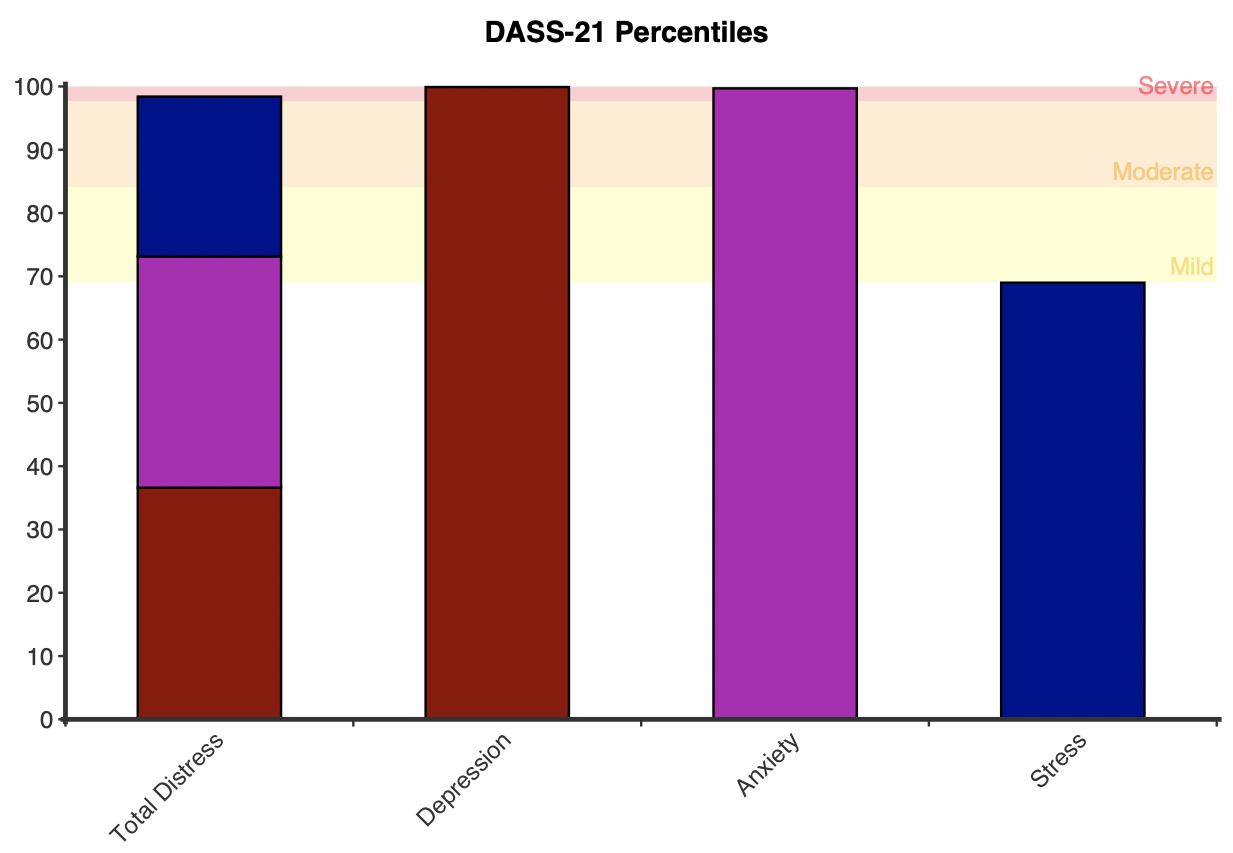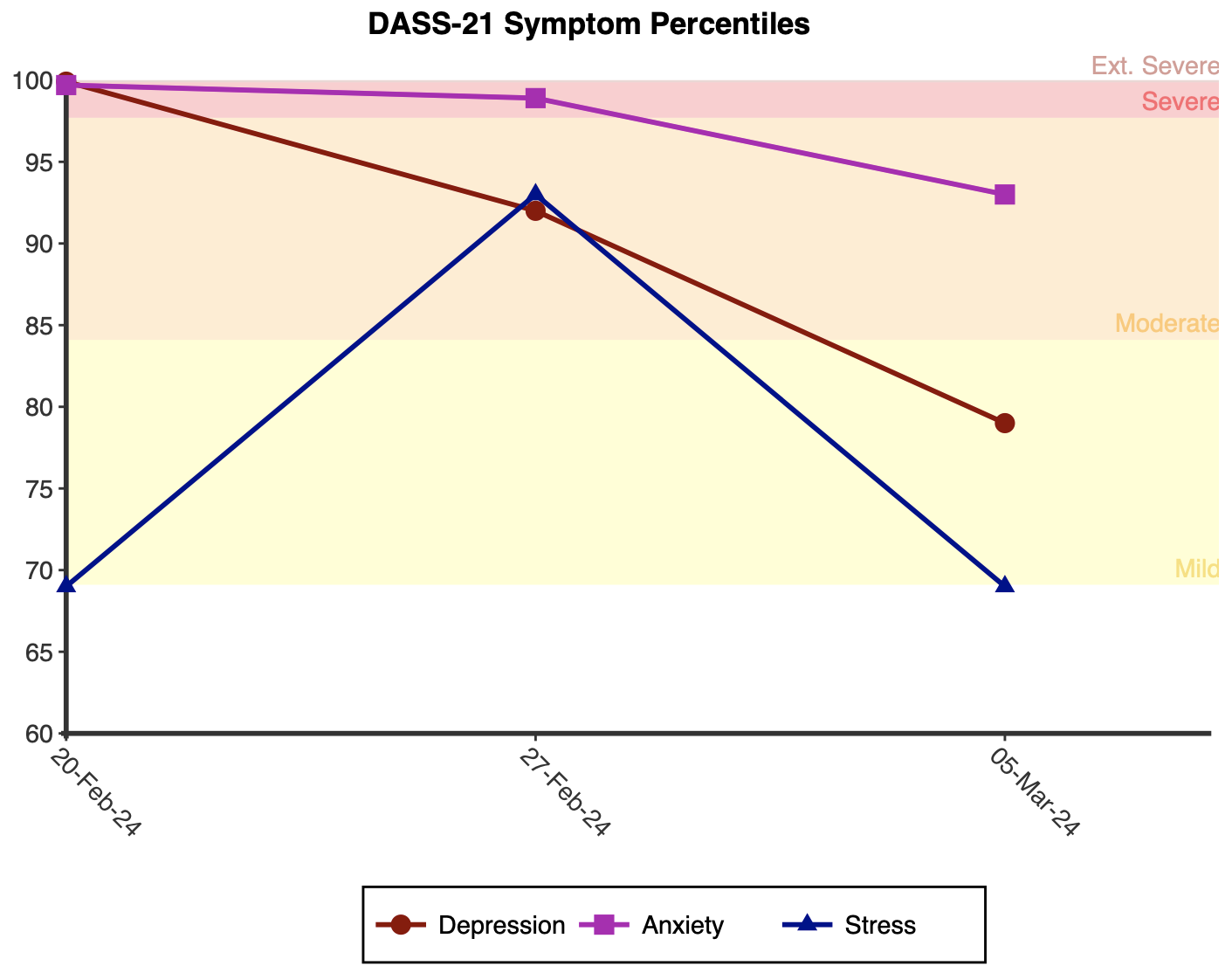The Depression Anxiety Stress Scales – 21 (DASS-21) is 21-item self-report measure designed to assess the severity of general psychological distress and symptoms related to depression, anxiety, and stress in adults older adolescents (17 years +).
There are seven items allocated to each subscale:
Example DASS-21 items:
The DASS-21 is the short form of the DASS-42. There are two other versions of the DASS: a youth version, the DASS-Y, and a shorter version, the DASS-10. The DASS-21 is suitable for clinical settings to assist in diagnosis and outcome monitoring, as well as non-clinical settings as a mental health screener.
The DASS is based on a dimensional rather than a categorical conception of psychopathology, and scores emphasise the degree to which someone is experiencing symptoms rather than having diagnostic cut points. The overall score for the DASS-21 can provide an indication of general psychological distress (Henry & Crawford, 2005).
As the three subscales of the DASS have been shown to have high internal consistency and to yield meaningful discriminations, the subscales meet the needs of both researchers and clinicians who wish to measure current state or change in state over time (e.g., in the course of treatment). It is a useful tool for routine outcome monitoring and can be used to assess the level of treatment response.
Scores are presented as a total score (between 0 and 63) and a score for the three subscales (between 0 and 21). In addition, percentiles are computed based on a community samples (Henry & Crawford, 2005; Lovibond & Lovibond, 1995).

Scores for each subscale are categorised into five severity ranges: normal, mild, moderate, severe and extremely severe. The severity labels are used to describe the full range of scores in the population, so ‘mild’ for example means that the person is above the population mean but probably still below the typical severity of someone seeking help (i.e. it does not mean a mild level of disorder). The severity levels are determined by z-scores from the DASS manual (Lovibond & Lovibond, 1995). Note: The raw scores presented in the table are not doubled scores (so they do not match the DASS-42 raw scores), but the DASS-21 raw scores are doubled in the backend of our system to conform with the recommendations on the DASS website (see FAQ 30) to ensure consistency in the allocation of percentiles and descriptors with the DASS-42.

Each of the three DASS-21 scales contains 7 items:
The primary difference between the stress and anxiety subscales lies in anxiety’s focus on acute responses and stress’s focus on chronic tension. Anxiety is more about the immediate, physiological response to perceived threats, involving fear and the body’s fight-or-flight reaction. Stress, on the other hand, encompasses a broader, more sustained response to ongoing demands that exceed an individual’s resources and coping mechanisms, leading to difficulties relaxing.
On first administration a bar graph is presented showing the percentiles for general psychological distress (the total score, labelled as ‘Total Distress’) and the three subscales.

When administered more than once, two graphs are produced showing change in symptoms over time. Firstly, the DASS-21 total score (indicative of general psychological distress) is plotted to show change over time. The use of raw score emphasise the visual representation of change for extremely severe levels of distress which might otherwise be obscured by little apparent change in percentile terms. The maximum and minimum values on the y-axis of this plot will change dependent upon the scores, so the y-axis might present as truncated to enhance the practitioner’s ability to observe change in these scores.

The subscale percentiles are graphed over time, with the plot indicating the level of symptoms compared to the general population. The y-axis for this plot may be truncated, dependent upon the scores for the client, to enhance the ability of the practitioner to observe changes. Given the dimensional nature of psychological distress it may be more useful to consider even small changes in symptoms over time, rather than focusing on categorical differences.
The DASS-21 was initially developed using a sample university students, with the items subsequently checked for validity against outpatient groups including patients suffering from anxiety, depression and other mental disorders (Lovibond & Lovibond, 1995).
The internal reliability of the total scale is .93. For the depression scale, reliability is .88, .82 for the anxiety subscale, and .90 for the stress subscale (Henry & Crawford, 2005). Confirmatory factor analysis (CFA) has confirmed that the DASS-21 has a four factor structure – the three subscales and a general psychological distress factor that is determined by the overall score (Henry & Crawford, 2005). This model was the best-fitting out of those tested and provided a good model fit (x2 = 893.7, df = 162, CFI = 0.94, SRMR = .03, RMESA = 0.05). Construct validity has been supported through correlations with other measures of depression, anxiety, and stress, indicating moderate to strong relationships (Brown et al., 1997). Test-retest reliability coefficients over a two-week interval has been found to be satisfactory, ranging from .71 to .81 for the Depression subscale, .74 to .81 for the Anxiety subscale, and .81 to .89 for the Stress subscale (Antony et al., 1998).
The DASS-21 has been extensively normed, with data used for interpretive purposes based on a sample of 1,794 (815 male, 979 female) non-clinical adults (18 – 91 years of age; Henry & Crawford, 2005). The percentile for general psychological distress (the overall score) is based upon Henry & Crawford’s data (mean = 9.43, sd = 9.66). The subscale percentiles were based upon Lovibond & Lovibond’s (1995) original data (n = 1,044 males, 1,870 females; 17 – 69 years of age) where a percentile table could be inferred for enhanced accuracy (see Table 9 and Figure 3 of the DASS manual).
The severity levels are determined from the DASS manual (Table 9; Lovibond & Lovibond, 1995), which translate to the following percentile ranges:
The raw scores can be classified as follows:
Reliable change scores have been determined by NovoPsych from data collected between January 2013 and February 2024 where clients had completed multiple DASS-21 assessments. Firstly, ‘normal’ severity data was excluded to ensure that analysis was only conducted on individual’s presenting with clinically significant distress. The resultant sample sizes were 97,114 for the total score, 90,947 for the depression subscale, 88,086 for the anxiety subscale, and 86,371 for the stress subscale. To allow for practitioners to monitor change within the subscales and for overall general psychological distress, four reliable change scores were calculated. Reliable change scores were calculated using the Jacobson-Truax method of clinical significance classification (Jacobson & Truax, 1991) using calculated Cronbach alpha’s from the NovoPsych data. The internal reliabilities used were 0.94 (overall score), 0.93 (depression), 0.86 (anxiety), and 0. 88 (stress). The reliable change score for the depression, anxiety, and stress subscales was 4 whereas the reliable change score for overall psychological distress was 7.
Lovibond, S.H.; Lovibond, P.F. (1995). Manual for the Depression Anxiety Stress Scales (2nd ed.). Sydney: Psychology Foundation (Available from The Psychology Foundation, Room 1005 Mathews Building, University of New South Wales, NSW 2052, Australia.
For full interpretive information please purchase the DASS manual at http://www2.psy.unsw.edu.au/groups/dass/order.htm
Antony, M. M., Bieling, P. J., Cox, B. J., Enns, M. W., & Swinson, R. P. (1998). Psychometric properties of the 42-item and 21-item versions of the Depression Anxiety Stress Scales in clinical groups and a community sample. Psychological Assessment, 10(2), 176–181. https://doi.org/10.1037/1040-3590.10.2.176
Brown, T. A., Chorpita, B. F., Korotitsch, W., & Barlow, D. H. (1997). Psychometric properties of the Depression Anxiety Stress Scales (DASS) in clinical samples. Behaviour Research and Therapy, 35(1), 79–89. https://doi.org/10.1016/s0005-7967(96)00068-x
Henry, J. D., & Crawford, J. R. (2005). The short-form version of the Depression Anxiety Stress Scales (DASS-21): construct validity and normative data in a large non-clinical sample. The British Journal of Clinical Psychology, 44(2), 227–239. https://doi.org/10.1348/014466505X29657
Jacobson, N., & Truax, P. (1991). Clinical significance: a statistical approach to defining meaningful change in psychotherapy research. Journal of Consulting and Clinical Psychology, 59(1), 12–19. https://doi.org/10.1037//0022-006X.59.1.12
NovoPsych’s mission is to help mental health services use psychometric science to improve client outcomes.
© 2023 Copyright – NovoPsych – All rights reserved